Boeing Takes Wraps Off Revolutionary Airliner
ANN REALTIME REPORTING 07.08.07 1930 EDT: The
Dreamliner has made its entrance. Following an
extremely protracted opening ceremony -- in which seemingly
everyone but Zippy the Wonder Squirrel extolled the virtues of
globalization, quieter airliners, and more hospitable cabin
environments -- Boeing unveiled the plane it believes will
revolutionize the industry: the carbon-fiber composite-bodied
787.
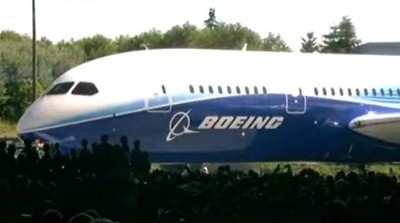
In an unusual move, flight attendants representing the 47
airlines which have ordered the 787 to date stood at stage center
as Boeing took the wraps off the first plane, which was towed over
to the hangar from the paint shop during the hour-long
introduction.
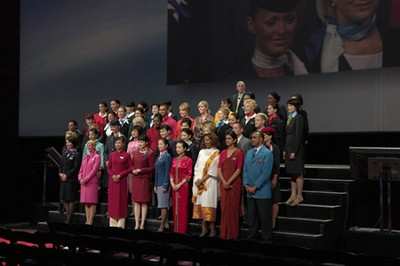
The event was broadcast in nine different languages via
satellite and Webcast. Boeing states the unveiling was
transmitted in more than 45 countries using 35 satellite TV
networks (alas, not without some early difficulties with
audio.)
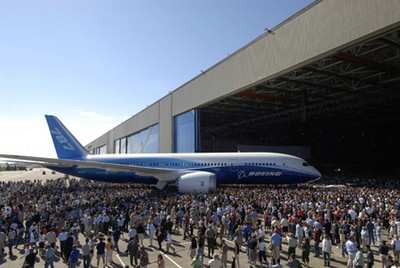
In the hours leading up to the unveiling, Boeing announced a new
order for the Dreamliner: Air Berlin ordered 25 787-8s. The order,
valued at $4 billion list, is the single largest placed by any
European carrier, and brings the total number of 787s ordered
worldwide to 677. Air Berlin is securing 10 options and 15 purchase
rights for additional 787s.
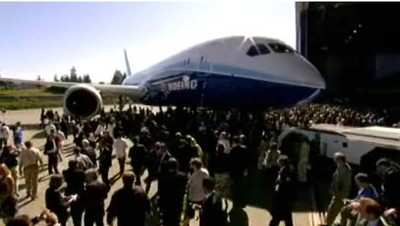
"This has been a wonderful and exciting day to celebrate this
breakthrough airplane with our customers, employees, supplier
partners and our communities," said Scott Carson, Boeing Commercial
Airplanes president and CEO. "We are gratified that the 787 has
been so strongly validated in the marketplace by our customers.
Their response is proof that the Dreamliner will bring real value
to our airline customers, passengers and the global air
transportation system."

On Saturday, Boeing also honored its 7-Series family of
airplanes with a special show, featuring customers' Boeing-produced
airplanes.
The airplanes on display at Boeing Field included an Omega Air
707; an AirTran Airways 717; a FedEx 727; an Alaska Airlines
737-800; the Rolls-Royce Trent 1000 Flying Test Bed 747-200; a
Continental Airlines 757; a Delta Air Lines 767; and Air France's
777-300ER (Extended Range). In addition, the Boeing 747-400
Dreamlifter, which transports segments of the 787 fuselage to
Everett for assembly, was on static display.
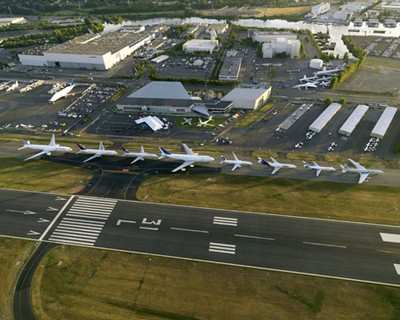
Each airplane -- the 707 through the 777 -- took off from Paine
Field, adjacent to Boeing's Everett, WA facility, and landed at
Boeing Field in Seattle,in sequence of airplane model numbers
matching to time, beginning with the 707 landing at 7:07 p.m.
Pacific time. The special display was part of a Boeing-sponsored
event held at The Museum of Flight as part of the weekend's
activities for the 787 Premiere.
ORIGINAL REPORT
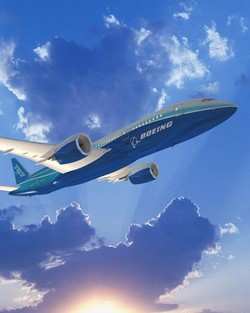 0001
EDT: Sunday at 1830 EDT (1530 PDT) is the moment some
15,000 Boeing employees and subcontractors, and millions of
aviation buffs around the world, have been waiting for: the time
the American planemaker is slated to roll out the first completed
787 Dreamliner.
0001
EDT: Sunday at 1830 EDT (1530 PDT) is the moment some
15,000 Boeing employees and subcontractors, and millions of
aviation buffs around the world, have been waiting for: the time
the American planemaker is slated to roll out the first completed
787 Dreamliner.
As ANN reported, Boeing is
preparing a lavish ceremony, hosted by NBC news broadcaster Tom
Brokaw and scheduled to be transmitted throughout the globe via
satellite television and webcasts. As many as 100 million are
expected to tune in, Boeing tells the Chicago Tribune.
While many workers have seen segments of the Dreamliner, for
many it will be the first time they will see the first all-new
Boeing jet since 1994's rollout of the 777 in all its glory.
"You're just going to look at this thing in amazement and go,
'Holy smokes,'" said Tom Wroblewski, president of International
Association of Machinists and Aerospace Workers District 751, which
represents the Boeing workers in Everett, WA who have worked
furiously to meet the planemaker's rollout deadline.
While rollout of the first new model aircraft is a heralded
milestone for any planemaker, the true tests for the Dreamliner
still lay ahead. Boeing is scheduled to fly the first 787 sometime
between mid-August and late September, and that flight will be
watched nervously by the customers who have ordered over 660 planes
to date.
Mike Bair, vice-president and general manager of the 787
program, says it's a virtual certainty an unexpected problem will
crop up during those first flights. "We are going to find something
[on those flights]," Bair said. "We always do. There's a reason
it's called testing."
Two problems have already cropped up during assembly of the
first plane -- an industry-wide shortage of fasteners, and a
composite fuselage segment that didn't quite line up with its mate.
Boeing was able to work around both issues, though its unclear how
similar problems could affect the program once the 787 goes into
full-scale production.
At that is, perhaps, where the real question lies regarding the
787: how the many outside suppliers Boeing has contracted to
produce parts for the Dreamliner, will be able to handle the rigors
of Boeing's tight production schedule. The planemaker intends to
certify the 787 by May 2008, and deliver 149 aircraft before the
end of that year.
That's also the question rival Airbus is betting Boeing will
stumble on... as its 787-beater, the A350 XWB, isn't slated to
enter service until 2013 -- giving Boeing a five-year headstart in
the marketplace.

Randy Tinseth, vice president of marketing for Boeing Commercial
Airplanes, pooh-poohs whispers in the market that Boeing won't be
able to meet its own schedule.
"We tend to be a conservative and calculating company," Tinseth
said. "We have a plan to meet the commitments to our customers. I
fully expect we'll meet our commitments." Tinseth notes 22 of the
last 23 new Boeing aircraft have met their deadlines -- and the one
holdout, the 747-400, was only three months late.
Others aren't so sure, however.
"The real problems for capacity will not be Boeing; they'll be
the Japanese, the Italians and Spirit AeroSystems," said JSA
Research analyst Paul Nisbet, referring to the builders of the
wings and carbon-fiber fuselage barrels. "They're the ones who're
going to have to figure out how to build this complex thing at a
much faster rate."
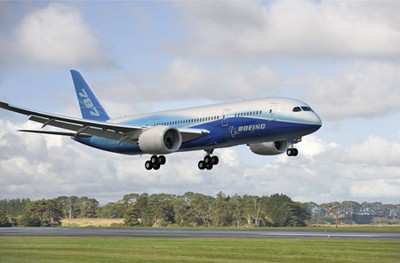
Wroblewski adds Boeing is betting on suppliers to be able to
handle tasks traditionally performed by Boeing workers... and so
far, many haven't been able to rise to the task.
"Right now, the suppliers haven't been able to deliver what the
company said they should deliver: a completed section," he
said.
Boeing maintains early issues are common on a new aircraft
program.
 ANN's Daily Aero-Linx (04.30.25)
ANN's Daily Aero-Linx (04.30.25) ANN FAQ: Turn On Post Notifications
ANN FAQ: Turn On Post Notifications Classic Aero-TV: Agile Aeros Jeff Greason--Disruptive Aerospace Innovations
Classic Aero-TV: Agile Aeros Jeff Greason--Disruptive Aerospace Innovations Aero-News: Quote of the Day (04.30.25)
Aero-News: Quote of the Day (04.30.25) ANN's Daily Aero-Term (04.30.25): Expedite
ANN's Daily Aero-Term (04.30.25): Expedite










